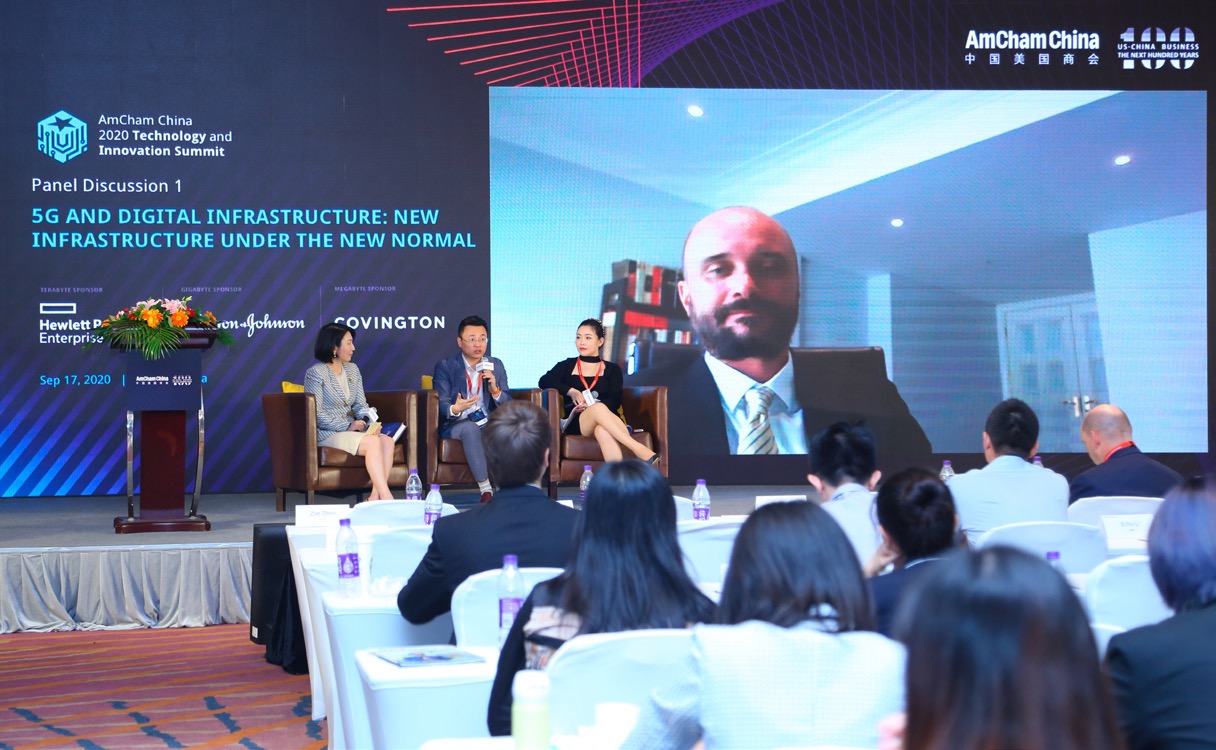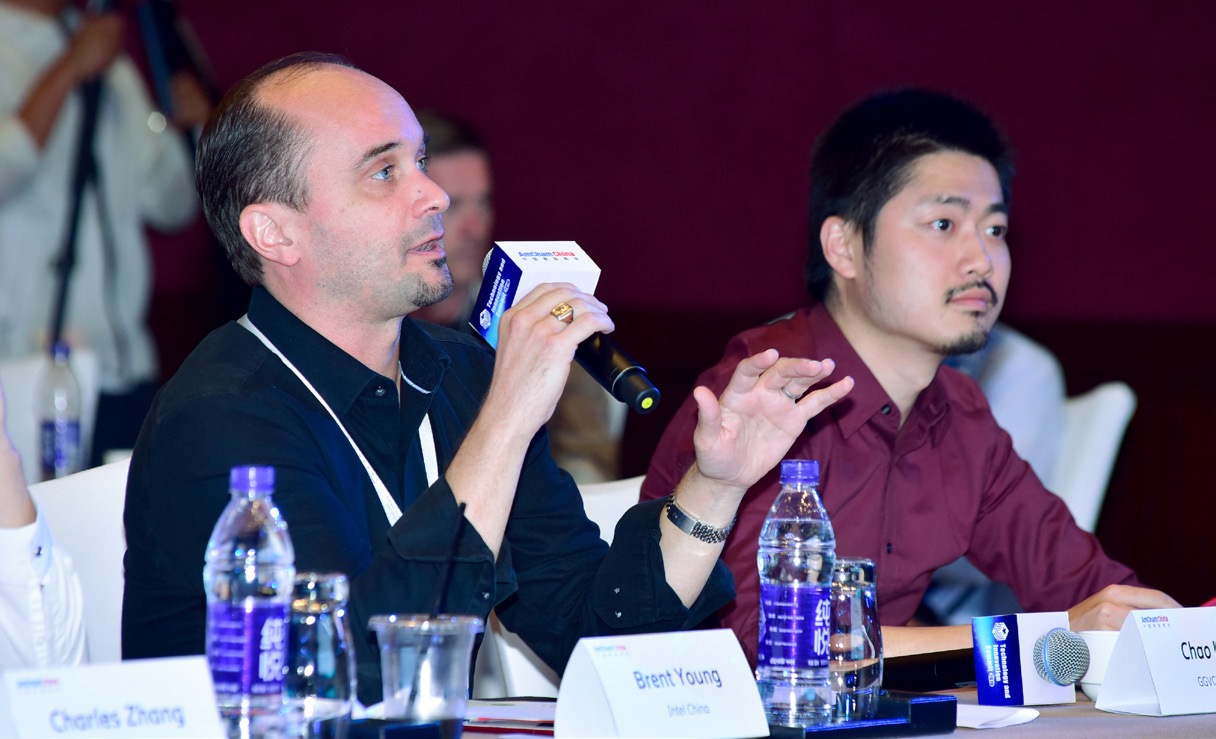In the latest in our series profiling current Board members, Brent Young discusses his role within the AmCham China community, reflects on his COVID-19 relief efforts, and analyzes the development of technology as a result of the pandemic.
Brent A. Young is Vice President of Intel Corporation and GM of the China Corporate Strategy Office, where he is responsible for Intel’s overall corporate strategy in China. Young joined Intel in 2006 as an open source software strategist before becoming the Chief of Staff/Technical Assistant to the EVP of worldwide sales and marketing. Young then moved to China and was the managing director of China Tech Ecosystem (CTE) Sales and China Product Marketing Group, where he led Intel’s overall product marketing in China as well as sales, customer, and go-to market strategies in the CTE. Under his leadership, the CTE sales team received Intel’s highest honor, the Intel Achievement Award.
Prior to joining Intel, he spent five years developing core product features in various software engineering positions at two startups, Curl Corporation and ShoppingList.com. He is a member of Montage Technology Group Limited’s board of directors, a mentor at Tsinghua University’s X-labs incubator, and was elected Vice Chair of AmCham China’s Board of Governors for 2021. Young earned both bachelor’s and master’s degrees from Cornell University and an MBA from Kellogg.
How long have you been connected to AmCham China, either as a member or board member? What encouraged you to run for the Board?
Brent Young: I’ve been involved with AmCham China for around five years, and Intel has been a member for 17 years. I became interested in joining the Board of Governors mainly for two reasons. First, I want to support the AmCham China community even more. I believe that active involvement from people who care passionately about building the US-China relationship through business is incredibly important – nothing gets done by sitting on the sidelines. Second, it is important to have my ear to the ground and be as well informed as possible. AmCham China provides a unique platform through which multiple perspectives across business segments and representing both sides of the Pacific are shared.
Can you share any stories about how AmCham China has been helpful to you in your own role in your company?
Brent Young: AmCham China has provided me with many opportunities, on both social and professional levels. I’ve developed deeper relationships with fellow industry executives, and with Chinese and American government officials. I’m a people person and enjoy mixing social and business engagements – they help develop deeper, more real relationships. For example, I accompanied the US Ambassador during his trip to Zhangjiakou to tour the impressive ski resorts being prepared for the 2022 Olympic Winter Games. I introduced how China integrated a sustainable development philosophy with the Olympics and how Intel has supported the Olympics with our various technologies. That experience was social, but also business-related. I was able to develop a different kind of relationship with the officers from the Embassy rather than just meeting them at a dinner party.
Likewise, through AmCham China connections or events, I’ve gone golfing with both US and Chinese colleagues, or toured the Greater Bay Area, including meeting Carrie Lam and her team in Hong Kong. As a result, I can reach a deeper level of understanding on what’s really going on, from both policy and practice perspectives. Being an active participant of the AmCham China community really helps to fill in blind spots by hearing differing viewpoints and learning what other people think and see.
How has your leadership and guidance as an AmCham China Board helped one or more members?
Brent Young: I would highlight two recent examples – COVID-19 support and the Technology and Innovation (T&I) initiative. 2020 was my first year on the Board, and as if the trade dispute wasn’t enough pressure on us all, the COVID-19 pandemic really escalated things. In the early months of the crisis, I helped the AmCham China source PPE, aid frontline workers, manage donations of PPE, and much more. At the same time, I was also heading up Intel’s COVID-19 response team across China. Being involved in both taskforces enabled me to bridge information across the teams, cross check and verify to make sure things were accurate and clear, and help keep people safe and productive by being informed and supportive.
On the Technology and Innovation (T&I) Initiative, for which Intel is a founding sponsor and active leader, we aim to help demystify technologies and provide insights and examples of how they can bring real business value across different segments, such as the application of AI in digital health, smart cities, or agriculture. The T&I Initiative helps technologists understand the market better and segment specialists understand how technologies can accelerate their business domains.
What were some of the biggest challenges and accomplishments from your time on those two COVID-19 task forces?
Brent Young: One of the biggest challenges was mentally compartmentalizing the magnitude of the situation while simultaneously trying to stay focused and devise solutions to help people. When teams are under an immense amount of pressure, it sometimes becomes hard to make decisions. Intel’s headquarters and local emergency response teams got up and running quickly. Everyone was focused on working together to keep people safe, first and foremost, and keep the business running thereafter. We knew all around the world people would be turning to technology to stay informed, stay safe, and remain productive. Keeping our people safe and our supply chains running were critical to helping the world get through this.
On the AmCham China side, I experienced exactly the same performance. The staff, Board of Governors, and member companies pooled information, shared insights and needs, and identified where we could help, be it sourcing PPE or the Chamber’s charter flight, which helped bring those stranded abroad back to China safely and efficiently.

What does AmCham China mean to you and how would you like to see it develop in the future? What is the key to staying relevant as an organization?
Brent Young: I think AmCham China represents a group of like-minded people who are truly invested in doing everything they can to help solidify a great relationship between the US and China through business. Our community can provide value to the members by representing the voice of US business in China when it comes to working with Chinese policymakers. This past year emphasized the importance of this community. From COVID-19 to the complex world environment, business is arguably what stabilizes the relationship during difficult times. What I want to see AmCham China continue to do is be a role model for that stable relationship on an even higher stage. The more that we can help our members to represent a balanced voice of US business in China, the more we can really engage with and influence policymakers.
What technological trends do you believe will have a significant effect on business in China, especially in the short term? How will businesses pivot to accommodate these changes?
Brent Young: I think the digitalization and “smart-ization” of everything is an uber macro trend that is going to affect almost everything. This integration of technology continues to democratize access to opportunity, education, medicine, and more, which I think is incredibly important. For example, there have been significant advancements in online learning that have come out of the pandemic, which give students the opportunity to study anywhere, as long as they have access to the internet. Professionals can meet with anybody, anywhere. You can visit the doctor from home. That, I think, is the real opportunity we get from technology, not just in China, but in the world.
Intel’s social equity initiative, RISE, relates to this technological trend. The purpose of RISE is to be a North Star in which we help create world-changing technology that enriches the lives of every person on earth – where the technology should be responsible, innovative, sustainable, and enabling. As our CEO Bob Swan has said, we integrated RISE strategy into our business operations and we want to bring a positive impact to society, world, and to our earth.
In your current role as Vice President at Intel China, what are some of the issues you have to deal with? What does a typical day look like for you?
Brent Young: In any typical day, there tends to be lot of syncing with headquarters and non-Asia based teams in the morning, and then, in the afternoon, more of a shift back to local teams. I really love being a bridge of leadership across the Pacific, by sharing insights on Intel culture, goals, and visions to help the local team feel more connected and integrated with the wider Intel company. Likewise, I really enjoy conveying and articulating the cultural elements of doing business in China to executives back at headquarters. This bridging of mutual understanding feels both personally rewarding and improves our execution a lot, because as teams understand each other better – especially across different cultures – they can grow and execute even better as One Intel, which is a core value of ours.
You are currently an executive-in-residence at Tsinghua University’s X-labs incubator, and a mentor and angel investor to a few startups. In what ways do you see the startup environment developing in China? How has COVID-19 had an impact on this space?
Brent Young: The startup environment in China is flourishing. There are incredibly creative, innovative, bold, and intelligent people in the startup community here, and China’s startup environment is very application-oriented, meaning that there is a lot of innovation and problem solving, focused on deploying solutions to address specific uses. There is a strong focus on combining technologies to address challenges or seize opportunities. This entrepreneurial spirit that I’m seeing also spans way beyond just technology. For example, at X-labs, a lot of the startups that I helped mentor are not technology startups. One startup was a group of architects trying to figure out how they position themselves ahead of the competition. Another was a skateboard design artist who is trying to figure out how to protect his IP. All of the major innovation hubs are really buzzing in Beijing, Shanghai, Shenzhen, and Chengdu, amongst others. Overall, the startup community is a very broad-based, creative, and solution-oriented community.
You started your career as a software engineer. How do you think that experience has helped you in the executive space?
Brent Young: That’s an interesting question because I am still, in my mind, a software and startup guy even though I’ve been at Intel, a silicon specialist, for 14 years! I was a programmer for five years at two different software startups and wanted to learn more, so I pursued an MBA at Kellogg and then joined Intel. I find that my diverse background helps me piece together connective tissues across strategy plans – combining insights on software, hardware, strategy, finance, and marketing to find creative ways we can accomplish our goals.
This article appears in Issue 4 of the AmCham China Quarterly Magazine, which you can read here.

